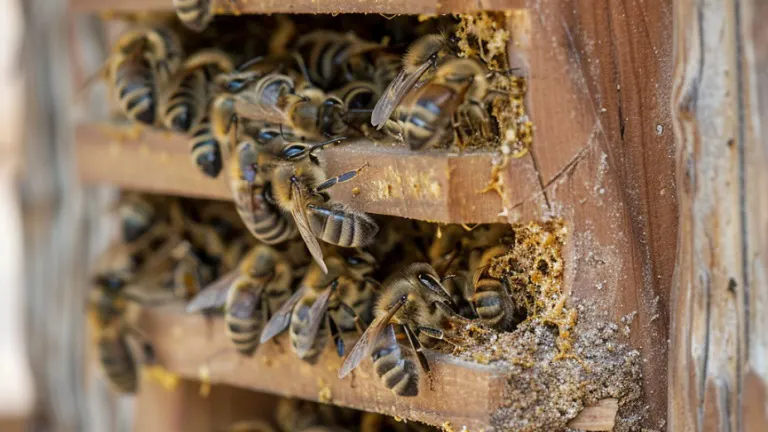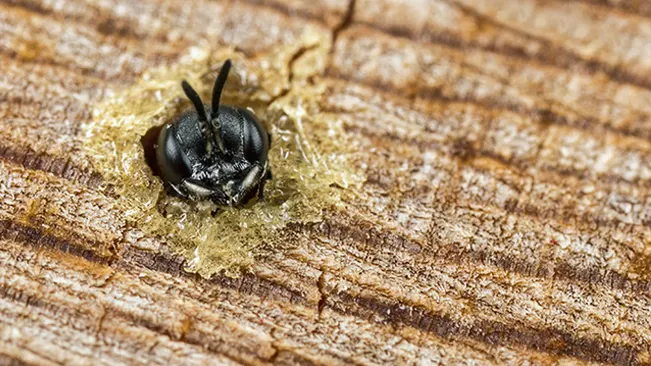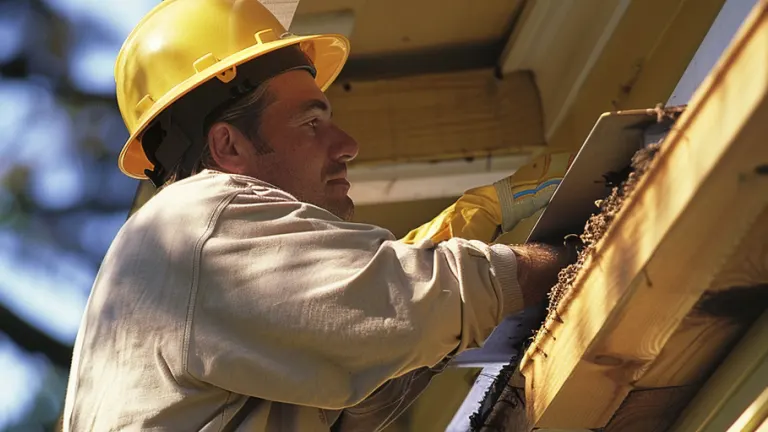How to Safely and Effectively Get rid of Wood Bees
- April 3, 2024
- 0 comment
Controlling wood bees, also known as carpenter bees, requires a balance between effective removal and ecological consideration. Safe and effective methods focus on deterrents and preventive measures that protect your wooden structures without adverse effects on these pollinators. By understanding their behavior and habitat preferences, you can create a strategy that keeps your home bee-free and maintains their crucial role in our environment.

List of How to Safely and Effectively Get rid of Wood Bees
- 1. Seal Nesting Holes
- 2. Use Natural Repellents
- 3. Opt for Bee-Resistant Materials
- 4. Install Physical Barriers
- 5. Utilize Noise and Vibrations
Removing wood bees can be environmentally friendly, often requiring simple physical modifications or natural repellents instead of chemicals. Adopting such methods not only protects your wooden structures but also supports the well-being of these essential pollinators in your garden.
Effectively managing wood bees is crucial for protecting wooden structures while respecting their ecological role. Through non-invasive strategies like using natural repellents and sealing entry points, you can deter these bees, preserving both your property and the environment.
5 ways to Safely and Effectively Deterring Wood Bees from Your Property

Addressing wood bee infestations requires effective, yet environmentally conscious methods. Our guide, “5 Key Steps for Safely and Effectively Deterring Wood Bees from Your Property,” provides practical and eco-friendly solutions to protect your wooden structures while maintaining the natural balance.
1. Seal Nesting Holes

In the battle against wood bees, sealing their nesting holes is a fundamental step. The first phase involves carefully inspecting wooden surfaces around your property for the distinctive round holes that carpenter bees create. Pay special attention to areas like decks, railings, and eaves where these bees are known to frequent.
Once you’ve identified the nesting sites, the timing of your action is crucial. It’s best to wait until the bees have left their nests, typically in late summer or early fall, to avoid trapping them inside. Sealing holes with bees still inside can lead to further damage as they attempt to escape or create new tunnels.
The final step in effectively sealing these holes involves choosing the right materials. Durable options such as wood putty or high-quality caulk are ideal for creating a long-lasting seal. Regular monitoring and maintenance, sealing any new holes as they appear, is vital to keeping your property free from future carpenter bee infestations.
Essential steps to effectively seal nesting holes and deter carpenter bees
- Identify Active Nests: The first step is to locate the holes created by carpenter bees. These are typically round, smooth, and about the diameter of a finger. You’ll often find them in untreated wood around your property, such as in decks, railings, or eaves.
- Wait for Bees to Leave: It’s important to wait until the carpenter bees have left their nests. This is usually in the late summer or early fall. Sealing the holes while bees are still inside may lead to trapped bees burrowing deeper into the wood or finding alternative exits, causing more damage.
- Choose the Right Sealing Material: Once the bees have vacated, use a durable sealing material like wood putty or exterior-grade caulking. These materials are effective at closing the holes and preventing bees from re-entering or new bees from using the holes.
- Regular Inspection and Maintenance: After sealing the holes, inspect your property regularly for new carpenter bee activity. Immediate action to seal any new holes will help keep your property free from further infestations and minimize the likelihood of wood damage.
2. Use Natural Repellents

Using natural repellents like citrus or almond oils, which have strong scents, can effectively deter wood bees from nesting on your property. These eco-friendly options are safe for the environment and other insects, and their efficacy increases with regular application during peak bee activity seasons.
Garlic or vinegar solutions can also repel wood bees effectively when sprayed around potential nesting areas, and consistent application of these accessible home remedies enhances their deterrent effect.
Incorporating bee-repelling plants like lemon balm, eucalyptus, or citronella into your landscape not only beautifies your garden but also naturally deters wood bees, serving as both a functional and aesthetic solution.
Essential steps for using natural repellents
- Select the Right Natural Repellents: Begin by choosing effective natural repellents such as citrus or almond oil. These oils are known for their strong scents that are unappealing to carpenter bees, making them effective in keeping these pests away from your property.
- Prepare the Repellent Solution: Mix the selected oil with water or another suitable carrier, creating a solution that can be easily sprayed or applied around potential nesting sites like eaves, deck railings, and wood siding.
- Apply Repellents Regularly: For maximum effectiveness, consistently apply the repellent solution around your property, particularly during peak bee activity seasons. Regular application is key to maintaining an environment that is uninviting to wood bees.
- Combine with Other Deterrents: While natural repellents are effective, combining them with other methods such as sealing holes and using bee-resistant materials can provide a more comprehensive approach to deterring wood bees.
3. Opt for Bee-Resistant Materials

Choosing bee-resistant materials is a crucial step in deterring wood bees effectively and safely. By opting for hardwoods or treated and painted woods for outdoor structures like decks and eaves, you reduce the likelihood of carpenter bee infestations, as these materials are less appealing for their nesting.
This proactive approach not only deters wood bees but also adds durability and longevity to your structures. Incorporating bee-resistant materials into your property’s design can also enhance its aesthetic appeal. Materials like cedar and teak not only discourage carpenter bees but also add a natural, elegant touch to outdoor spaces.
Moreover, synthetic options such as composite decking or vinyl sidings offer long-term resistance to bee infestations and require less maintenance, making them an ideal choice for homeowners looking for both style and functionality in their outdoor areas.
Essential steps for opting for bee-resistant materials
- Research and Choose Bee-Resistant Woods: Start by identifying types of wood that are less attractive to carpenter bees, such as hardwoods like oak, maple, or teak. These woods are harder and more challenging for bees to bore into, making them a less preferred choice for nesting.
- Consider Synthetic Alternatives: For areas prone to bee infestations, consider using synthetic materials like composite decking or vinyl siding. These materials mimic the look of wood but are impervious to bee boring, offering long-term resistance to infestations.
- Apply Protective Coatings: If replacing existing structures isn’t feasible, treat the wood with paints, stains, or varnishes. These coatings not only enhance the appearance of the wood but also make the surface harder and less inviting for bees to drill into.
- Regular Inspection and Upkeep: Even after opting for bee-resistant materials, regular inspections of your property are crucial. Checking for signs of wear, deterioration, or damage ensures the materials retain their effectiveness in deterring wood bees over time.
4. Install Physical Barriers

Installing physical barriers is a practical step in deterring wood bees. By covering exposed wood, especially in vulnerable areas like eaves and deck railings, with metal flashing or wire mesh, you create a robust barrier that prevents bees from accessing the wood to nest and lay eggs.
This method is effective and non-invasive, ensuring that your property remains both aesthetically pleasing and free from carpenter bee damage. The installation of these barriers can be tailored to blend seamlessly with your property’s design, ensuring no compromise on aesthetics.
Furthermore, these physical barriers not only deter carpenter bees but also add an extra layer of protection against other wood-damaging pests and elements. Regularly inspecting and maintaining these barriers ensures their continued effectiveness, making them a long-term solution for safeguarding your wooden structures.
Essential steps for installing physical barriers
- Identify Vulnerable Areas: Start by identifying the areas of your property most susceptible to wood bee infestation, such as eaves, deck railings, siding, and outdoor wooden furniture. These are the primary spots where physical barriers will be most effective.
- Choose Appropriate Materials: Select durable materials for the barriers, such as metal flashing or fine wire mesh. These materials should be robust enough to prevent bees from boring through while being suitable for outdoor use and exposure to weather conditions.
- Ensure Proper Installation: Install the barriers securely, making sure they cover all potential entry points. This might involve cutting the materials to size and fastening them firmly in place to ensure no gaps are left where bees could enter.
- Maintain and Inspect Regularly: Regular maintenance is key to ensuring the effectiveness of these barriers. Periodically check for any damage or wear and repair or replace parts as necessary to maintain a strong, impenetrable barrier against carpenter bees.
5. Utilize Noise and Vibrations

Utilizing noise and vibrations as a deterrent for wood bees is a novel and non-toxic approach. By installing devices that create constant vibrations or noise, such as wind chimes or speakers playing music, you can make the environment less inviting for these bees.
The vibrations and sound waves disrupt the bees’ ability to comfortably nest and navigate, encouraging them to find more tranquil locations. In addition to traditional wind chimes, ultrasonic repellents can also be effective. These devices emit sound waves at frequencies that are unpleasant or disorienting to carpenter bees but are usually inaudible to humans.
Furthermore, the strategic use of these devices can be both functional and aesthetically pleasing. Incorporating them into your garden or patio design not only serves the purpose of repelling bees but also enhances the outdoor space.
Essential steps to effectively utilize noise and vibrations in deterring wood bees
- Identify Target Areas: First, pinpoint the areas around your property where carpenter bees are most active or likely to nest, such as wooden decks, eaves, or railings. These areas will be the primary focus for your noise and vibration deterrents.
- Install Noise-Making Devices: Place devices that create noise, such as wind chimes or outdoor speakers, in these identified areas. The sound produced by these devices doesn’t need to be overly loud; it just needs to create enough of a disturbance to make the environment less appealing to the bees.
- Consider Ultrasonic Repellents: For a more high-tech approach, ultrasonic repellents can be used. These devices emit sound waves at frequencies that are irritating to wood bees but are generally inaudible to humans, providing a discreet yet effective deterrent.
- Regular Evaluation and Adjustment: Monitor the effectiveness of these devices and adjust their location or settings as needed. It’s important to assess whether the noise or vibrations are effectively deterring the bees without causing a disturbance to you or your neighbors.
Conclusion
To effectively manage wood bee infestations, integrating a variety of strategies is key. Sealing existing holes prevents bees from returning to their nests, while using natural repellents like citrus and almond oils acts as a safe deterrent. Opting for bee-resistant materials in construction and applying physical barriers protects your property’s vulnerable areas. Lastly, employing noise and vibrations disrupts the bees’ nesting habits, driving them away without harm. These steps, when combined, offer a comprehensive and environmentally considerate approach to keeping wood bees at bay, safeguarding both your property and the local ecosystem.
Frequently Asked Questions (FAQs)
- What are wood bees?
Wood bees, commonly known as carpenter bees, are large bees that bore into wood to create nests. - Do wood bees sting?
Female carpenter bees can sting but are generally docile; males don’t sting but may act aggressively. - What damage do wood bees cause?
They bore holes into wood for nesting, which can cause structural damage over time. - How do I know if I have wood bees?
Look for round, smooth holes in wood and sawdust-like material, indicating their presence. - Are wood bees good for anything?
Yes, they are important pollinators, particularly for open-faced flowers and some crops. - Can I prevent wood bees from coming?
Yes, by painting or varnishing wood, using bee-resistant materials, and sealing cracks and crevices. - What natural methods deter wood bees?
Natural repellents like citrus oil, almond oil, and physical barriers like wire mesh are effective. - Are wood bees solitary or social?
Carpenter bees are solitary bees, with each female building her own nest. - When are wood bees most active?
They are most active during the spring and early summer, which is their nesting period. - Can wood bee holes be repaired?
Yes, holes can be filled with wood putty or caulk after bees vacate, to prevent return.

Charles Hayes
Forestry AuthorI'm Charles Hayes, I bring over 15 years of specialized expertise in landscaping and woodworking, blending artistic design with sustainable environmental stewardship. My career, fueled by a profound passion for the natural world, encompasses extensive education and hands-on experience in creating harmonious, eco-friendly outdoor spaces and responsibly managing forest resources. Recognized for my professional standing, I am committed to continuous learning and certification in cutting-edge practices. My expertise is not only reflected in my work but also in my contributions to community projects, educational workshops, and collaborations with industry leaders. As an authoritative voice in my field, I strive to share knowledge and promote environmentally conscious approaches, making me a trusted resource in landscaping and forestry.













Leave your comment